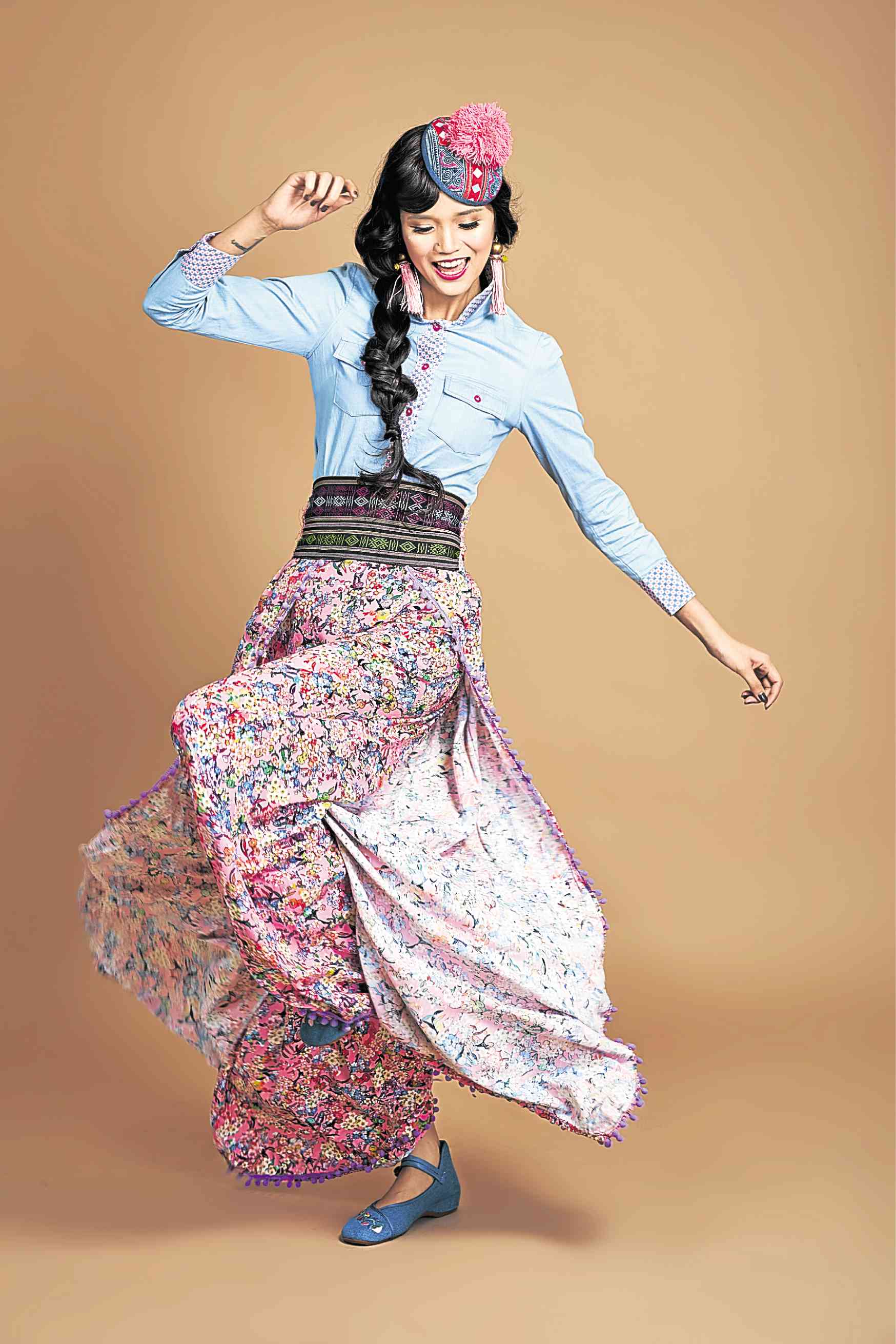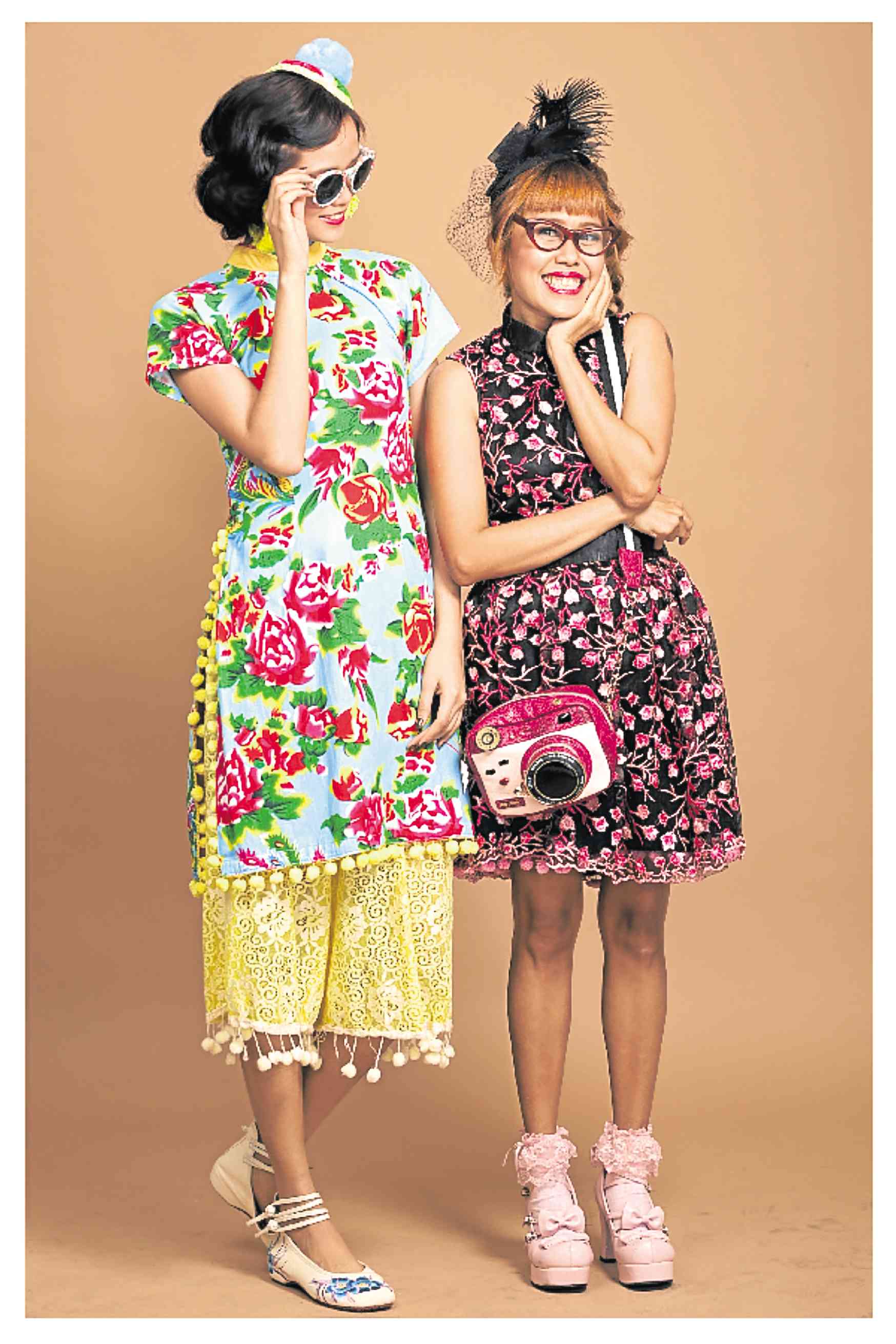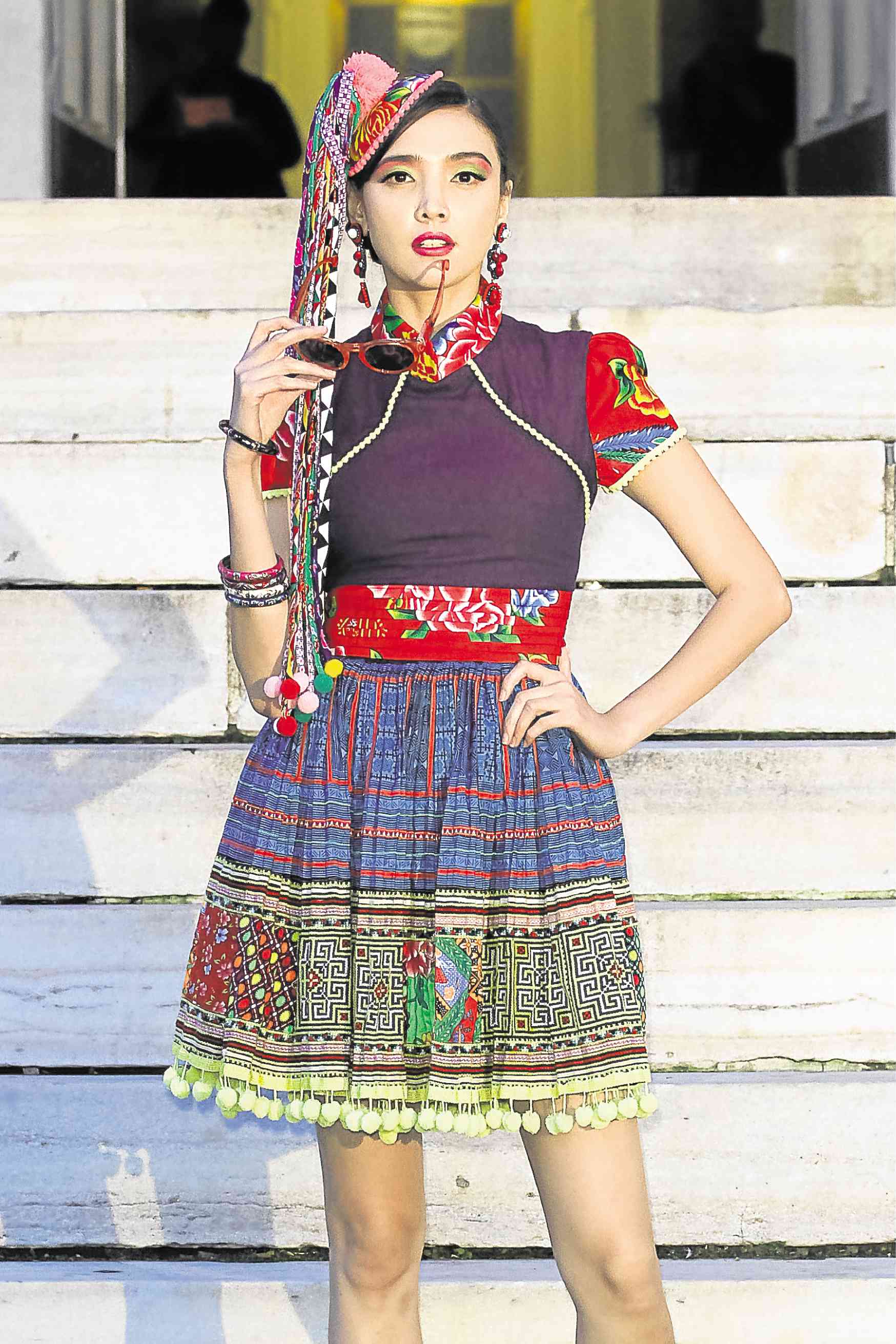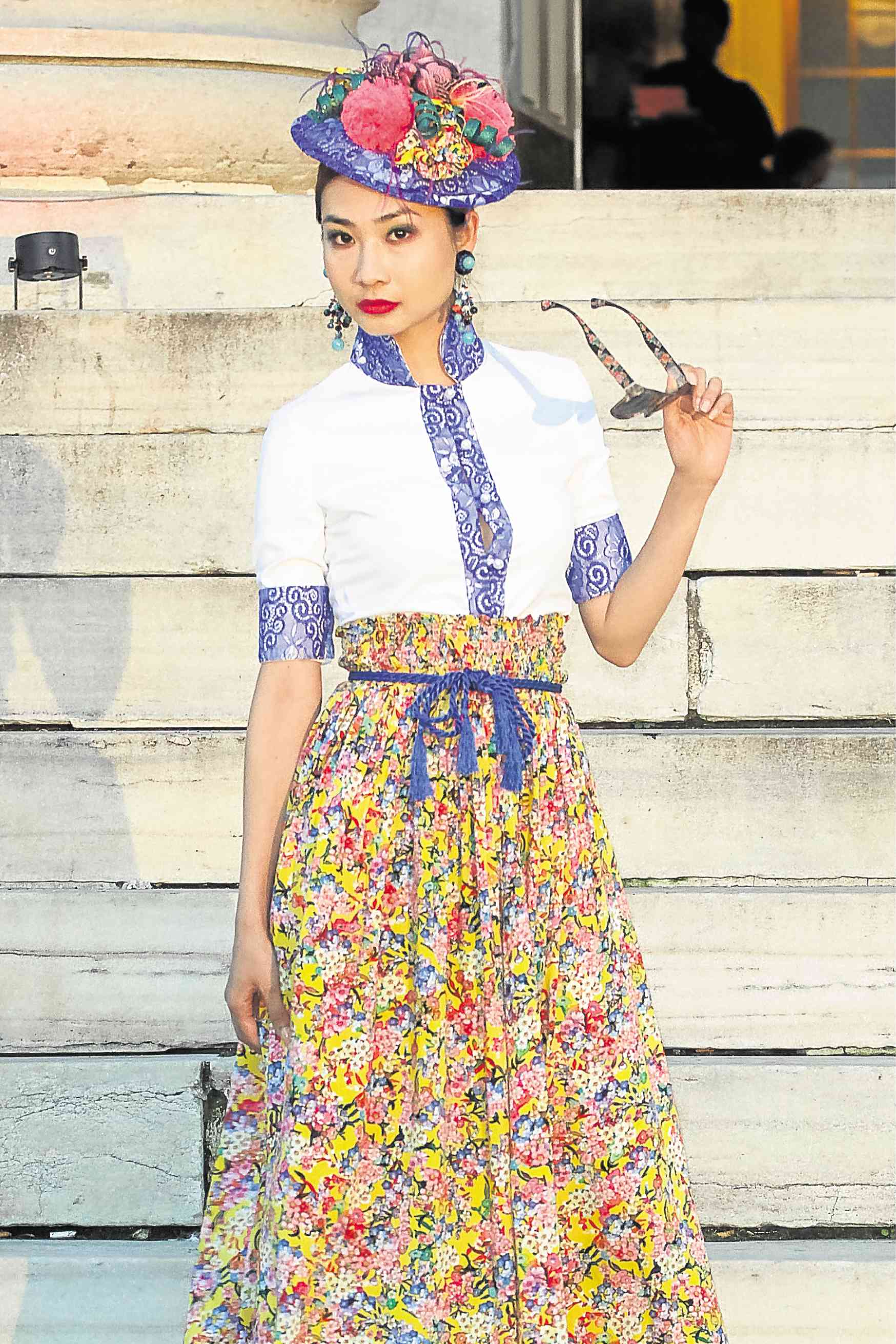
A look from Tracy Dizon’s “Miss Hanoi: La Douleur Exquise” collection made from local fabrics from Vietnam
The nice thing about being an independent brand is that it allows you to be true to your beliefs.
Streetwear designer and milliner Tracy Dizon recently bagged the inaugural Rise Art & Design Fashion Design Competition Award, launched by the label Rise Sport, a New York company specializing in sports apparel and accessories, in collaboration with Fashion Week Brooklyn.
Her winning collection, “Miss Hanoi: La Douleur Exquise,” consisted of an eclectic ensemble inspired by the Vietnamese áo dài, military uniforms and icons of Vietnamese history for an “imaginary local girl.”
Based in Manila, Dizon currently owns and directs the brand Tiara by Tracy Dizon, which makes hats and fascinators for the local and international markets. Her list of clients includes Filipino celebs Maxene Magalona, Sanya Smith, Tessa Prieto Valdes, Tokyo-based fashion editor Misha Janette and “Sex and the City” costume designer Patricia Field.
Often described as quirky, Dizon has a childlike sense of adventure in her use of bold prints and exaggerated silhouettes.
I recently interviewed this young designer on her beginnings and her views on cultural appropriation in design. I found truth, energy and freshness in her opinions.

Tracy Dizon (right) with model Yumikz Aleena —Rap Yu
What were the first steps you took in the world of fashion?
Subconsciously, I think I wanted to become a fashion designer since I was 5. I was the only child before my five other siblings were born. I was fascinated with different aspects of fashion like dressing up, fabric types, clothing, colors and costumes. I used to design our (Miriam College Pep Squad) uniforms and jackets. But back then, I didn’t think about fashion design as a possible career. It was just my hobby. It allowed me to express myself creatively.
Past the hobby phase, where and how did you learn to design clothes?
At University of the Philippines I took up BS Clothing Technology, much to my parents’ dismay.
Getting in was not easy, staying and completing the course was even harder. I had to take part-time jobs to fund some of my early projects. But I stuck it out, and the many hurdles became a constant motivating force.
What were your early experiences and forays into the fashion industry like?
Tough. I joined fashion design contests for about 13 years, just a year short of my son’s age. Some days we would go home empty-handed, and on some good days when I would win, I’d have extra money for my son’s diapers and other needs.
My first nationwide fashion competition was with the Fashion & Design Council of the Philippines in 2006.
I was also selected to be a Philippine representative to the 47th Japan Fashion Design Contest in 2009 with Veejay Floresca and Nicole Mori.
Japan opened up a whole world of possibilities and options for penetrating the international market.
My first real job was as a head stylist/costume designer for a local fantasy television series, “Lastikman.” I continued getting fashion-related jobs as fashion merchandiser for a retail company, stylist for music videos and fashion illustrator. I also made accessories.

Model Stephanie Retuya on the runway of Fashion Week Brooklyn for Tracy Dizon’s Spring/
Summer 2018 collection —PHOTOS BY SHAWN PUNCH
What design concepts interest you?
I think my signature style is my print-on-print-on-print-play. I love prints and patterns from florals to ethnic motifs.
I am and will always be young at heart and playful with my designs. In every collection I make, whether it’s a tea party collection or a minimalist collection, there will always be room for a cute baby doll dress.
What is your take on cultural appropriation?
I think my brand has always been grounded on intensive research. I respect my material, learn about it before I actually work on any design.
Making such a culturally charged collection is my way of sharing my Hanoi immersion. I love how I got to know the women of Hanoi by listening to their ideas and life experiences.
On appropriation, I find it sad that anyone or any brand would carelessly use a culture for the sake of trying to make a profit.
How would you describe your personal style?
It is a joyful combination of Gwen Stefani, Patricia Field and Betsey Johnson. I love having fun with clothes and embrace being feminine. I own more dresses and skirts than pants.
I still love being playful, but I find that in my 30s, I’ve developed a colorful bohemian vibe influenced by my travels and my passion for learning different cultures and subcultures.
You have a Pinoy Pop Collection for New York Fashion Week (The Society Fashion Week). What can viewers expect to see?
I want to show the world how colorful, happy and simply wonderful the Philippines is.
The colorful and vibrant Pahiyas harvest festival is the start-off point and inspiration. This includes delicacies like rice cakes, edible wafers, sapin-sapin and halo-halo. I want to create a wearable Filipiniana collection that can be flexible and worn for all occasions.

Model Virginia Liang on the runway of Fashion Week Brooklyn for Tracy Dizon’s Spring/Summer 2018 collection
What have you learned in your years designing?
I’ve learned humility. Someone or something else will always be better than you, but it should not stop you from improving your craft and honing your skill sets.
Always be kind because you’ll never know someone below you could be your next boss in the future.
Listen to your mentors and teachers as they will always guide you. Joey Samson, Jojie Lloren, Josie Natori are my mentors and I have kept their words of wisdom close to my heart.
My dream is to someday invest in agricultural land that can be planted to crops like banana palm whose byproduct is abaca, a beautiful and strong natural fiber that is woven to become sinamay. There’s so much talent, craftsmanship and organic materials here that’s not being put to good use. —CONTRIBUTED
[“Source-lifestyle”]
